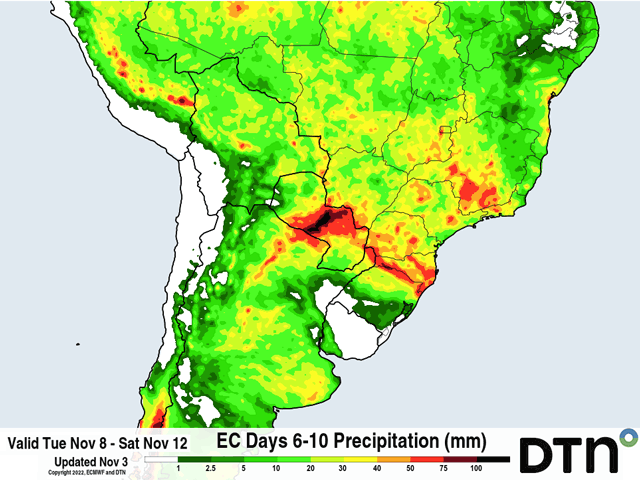South America Calling
Showers Returning to South America Next Week
A strong cold front pushed through South America Oct. 30 to Nov. 1. While showers along the front were moderate to heavy and in some cases came with hail, it has become almost completely dry behind it. With the front making it up almost to the equator, all of Argentina and almost all of Brazil outside of northeastern areas of the country have gone dry.
The dryness period continues into next week, though showers are set to return to both countries' primary growing areas later next week.
For Argentina and central Brazil, those showers start to move in Nov. 8-9. For southern Brazil, that occurs Nov. 10-11. That means more than an entire week of no rainfall for areas that see rain several times a week -- a big change.
For Argentina, where soil moisture is already very low, winter wheat that is filling continues to face production reductions and there are fears that the country will have to limit exports. If they do, Brazil might have to find a new trade partner. For corn and soybeans, planting has already been delayed significantly as producers await better chances for soil moisture for good germination and establishment.
P[L1] D[0x0] M[300x250] OOP[F] ADUNIT[] T[]
For Brazil, the situation is a little more encouraging. Soil moisture across the southern states of Parana and Mato Grosso do Sul are more than excellent and in some cases too wet to plant soybeans. The drier weather here should encourage more planting to be completed. Outside of any hail damage that came from the storms Oct. 31-Nov. 1, crops are in very good condition.
Farther north across central Brazil and in Rio Grande do Sul in southern Brazil, soil moisture is more patchy. There are some good areas and others that are not so good. Rains have been more irregular and the week of dry weather is not favorable.
However, the temperatures behind the front fell significantly, and heat stress is not indicated to be severe, helping to conserve those pockets of good soil moisture. The sunshine instead should encourage planting and growth. Mato Grosso has now surpassed last year's rapid planting pace as the quickest on record. That puts both the first soybean crop and second corn crop (safrinha corn) on pace for excellent yields if the weather cooperates.
Though the dryness over the next several days is not at all encouraging for yields, as we know here in the United States, it is when the crop is filling that rainfall matters the most for soybeans, which comes in December and January. As long as it does not go completely dry for too long, yields can still be excellent. With a period of rain set to return next week, the interim dryness should not be concerning for soybeans.
However, for full-season corn in southern Brazil, it is more concerning, especially as some of the early-planted crop should be nearing pollination. If the rains last long enough, disaster can be avoided. But it will depend on the rain.
Models are set to bring back the rains next week, but for how long? It is beyond most of the medium-range models forecast period, but longer-range models suggest that the rains over Argentina and southern Brazil will be brief, lasting about a week. Still, a couple of good periods of rain with more than 30 millimeters (1.2 inches) will go a long way as long as it does not get too dry behind it. Both the extended versions of the American GFS and ECMWF suggest that dryness returns for the end of November, giving about a one-week period of decent rainfall before going drier again. It may be enough to get some of the crop through in southern Brazil, but for those in Argentina, it is going to be a tough year should this forecast pan out.
For a more extended look at South American weather, join me at the 2022 DTN Virtual Ag Summit Dec. 12-13. Get all of the information you expect from DTN, from the comfort of your home or office. For details on the agenda and how to register, visit www.dtn.com/agsummit
John Baranick can be reached at john.baranick@dtn.com
(c) Copyright 2022 DTN, LLC. All rights reserved.






Comments
To comment, please Log In or Join our Community .